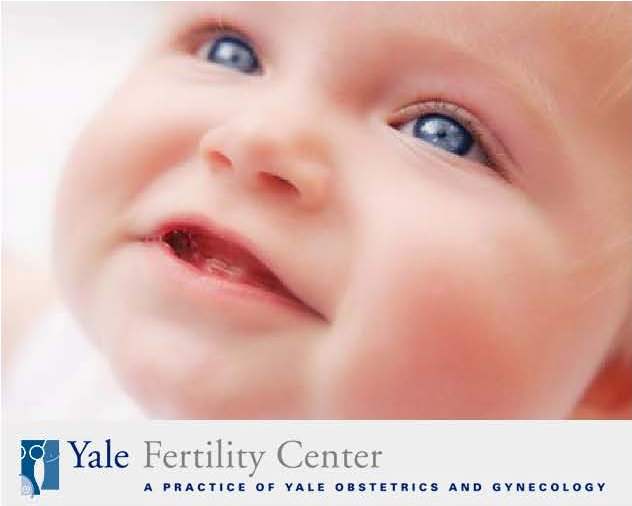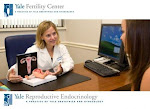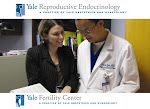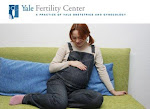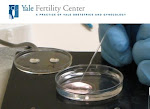Yale Fertility Center has extensive experience helping an infertile or same-sex couple finding an appropriate egg donor. Finding the right donor may take some time, but YFC offers flexibility during the process. “We make sure that you’ve got the donor you’re comfortable with,” says Dorothy Greenfeld, LCSW, Clinical Professor and psychological counselor at YFC. Couples meet with Greenfeld and discuss donor traits that are important to them. She then goes over YFC’s donor profiles with the intended parents. Though donation is strictly anonymous, the intended parents receive a great deal of information about the egg donor. In addition to health information, height, weight, and hair and eye color, as well as those of the donor’s relatives, couples learn about her education, her occupation, and her reproductive history, including details of any previous egg donations.
In contrast to the practice at some other egg-donation programs, couples at YFC are not placed on a waiting list for eggs, and they may decline a particular donor if they wish. What is the typical egg donor like? “They’re women who have often been touched by infertility in some way,” says Greenfeld. “They have a godmother who was infertile or they’ve worked with women who are infertile.” Successful egg donors tend to be active, educated young women who are in school or who are young mothers themselves. They know they face a months-long process that involves uncomfortable procedures, but they want to help others have babies, and they view donating eggs not as “giving away a baby” but as a way of giving the gift of a family to a couple in need.
Potential egg donors must be aged 21–30, in good physical and psychological health, and have at least a high school education. All potential YFC donors undergo extensive health screening by YFC faculty, as well as a psychological evaluation by Greenfeld.
Tuesday, January 13, 2009
In Vitro Fertilization
In vitro fertilization(IVF) involves fertilization outside the body in an artificial environment. This procedure was first used for infertility in humans in 1977 at Bourne Hall in Cambridge, England. To date, thousands of babies have been delivered worldwide as a result of IVF treatment. Over the years, the procedures to achieve IVF pregnancy have become more successful and affordable.
To accomplish pregnancy as a result of IVF, several steps are involved:
- Stimulation of the ovary to produce several fertilizable oocytes (eggs)
- Retrieval of the oocytes from the ovary (from the vagina)
- Fertilization of the oocytes and culture of the embryos in the IVF Laboratory
- Placement of the embryos into the uterus for implantation (embryo transfer or ET)
What Types of Infertility Might Be Helped by IVF? Absent fallopian tubes or tubal disease that cannot be treated successfully by surgery. Endometriosis that has not responded to surgical or medical treatment. A male factor contributing to infertility, in which sperm counts or motility are low but there are enough active sperm to allow fertilization in the laboratory. Unexplained infertility that has not responded to other treatments. Infertility secondary to sperm antibodies. Due to the high success of IVF and intrauterine embryo transfer, GIFT (Gamete Intra Fallopian Transfer) and ZIFT (Zygote Intrafallopian Transfer) techniques are rarely used in current practice. Intracytoplasmic Sperm Injection (ICSI) is a relatively new micromanipulation technique developed to help achieve fertilization for couples with severe male factor infertility or couples who have had failure to fertilize in a previous in vitro fertilization attempt. The technique involves very precise maneuvers to pick up a single live sperm and inject it directly into the center of a human egg. The procedure overcomes many of the barriers to fertilization and allows couples with little hope to achieve a successful pregnancy. At Yale the ICSI procedure was first used in 1994 and the first successful birth was achieved in 1995.
The ICSI Process
ICSI is a tool available in the IVF laboratory to achieve fertilization. The initial steps in preparation for ICSI are the same as for IVF:
- Stimulation of the ovary to produce several fertilizable oocytes (eggs)
- Retrieval of the oocytes from the ovary (through the vagina
- Fertilization of mature oocytes with ICSI
- Placement of the embryos into the uterus for implantation (embryo transfer or ET)
Fertilization by ICSI means that the micromanipulation specialist picks up the single live sperm in a glass needle and injects it directly into the egg.
To accomplish pregnancy as a result of IVF, several steps are involved:
- Stimulation of the ovary to produce several fertilizable oocytes (eggs)
- Retrieval of the oocytes from the ovary (from the vagina)
- Fertilization of the oocytes and culture of the embryos in the IVF Laboratory
- Placement of the embryos into the uterus for implantation (embryo transfer or ET)
What Types of Infertility Might Be Helped by IVF? Absent fallopian tubes or tubal disease that cannot be treated successfully by surgery. Endometriosis that has not responded to surgical or medical treatment. A male factor contributing to infertility, in which sperm counts or motility are low but there are enough active sperm to allow fertilization in the laboratory. Unexplained infertility that has not responded to other treatments. Infertility secondary to sperm antibodies. Due to the high success of IVF and intrauterine embryo transfer, GIFT (Gamete Intra Fallopian Transfer) and ZIFT (Zygote Intrafallopian Transfer) techniques are rarely used in current practice. Intracytoplasmic Sperm Injection (ICSI) is a relatively new micromanipulation technique developed to help achieve fertilization for couples with severe male factor infertility or couples who have had failure to fertilize in a previous in vitro fertilization attempt. The technique involves very precise maneuvers to pick up a single live sperm and inject it directly into the center of a human egg. The procedure overcomes many of the barriers to fertilization and allows couples with little hope to achieve a successful pregnancy. At Yale the ICSI procedure was first used in 1994 and the first successful birth was achieved in 1995.
The ICSI Process
ICSI is a tool available in the IVF laboratory to achieve fertilization. The initial steps in preparation for ICSI are the same as for IVF:
- Stimulation of the ovary to produce several fertilizable oocytes (eggs)
- Retrieval of the oocytes from the ovary (through the vagina
- Fertilization of mature oocytes with ICSI
- Placement of the embryos into the uterus for implantation (embryo transfer or ET)
Fertilization by ICSI means that the micromanipulation specialist picks up the single live sperm in a glass needle and injects it directly into the egg.
Assisted Reproduction Options for Same-sex Couples
The Yale Fertility Center (YFC) has for many years helped men and women become parents—and that includes same sex parents. Both lesbians and gay men who want children can seek treatment at YFC, where the available services include artificial insemination, egg donors, and gestational surrogates, or carriers. “More and more gay men are choosing to become fathers through surrogacy and donation,” says Dorothy Greenfeld, LCSW, a counselor at YFC. In addition, marriage is legal between same-sex couples in Connecticut, and many same-sex couples within either partnerships or marriages feel ready for children.
Greenfeld is the first person potential parents meet at YFC (except for those needing help only with insemination). She administers a psychological evaluation and gives them a detailed picture of what to expect from the long process of achieving parenthood. Part of her job is to ask the questions that potential parents may not have asked themselves.
For example, male couples often decide before going to YFC which of them will be the sperm donor. But Nature might not cooperate, and Greenfeld wants them to be prepared. “You might be very clear about who’s going to produce the sperm, but you might also be the guy who can’t produce the sperm,” she points out.
The Center works with couples to come up with individual solutions for their particular situation. Some seek simply an egg donor, a gestational surrogate to carry the pregnancy, or sperm. But more complex scenarios are possible. One lesbian couple at YFC achieved the “dream scenario,” in which one partner provided the egg and the other carried the pregnancy. And one pair of fathers had twins—one twin from each father’s sperm—with the help of a surrogate mother. Whatever arrangement is made, YFC requires that at least one potential parent be biologically connected to the child, providing either eggs, sperm, or womb.
Prejudices persist about gay parents, including fears that they will be less nurturing or that their children are less likely to marry, but these are subsiding amid recognition that gay couples make good parents. Greenfeld has written about the need to overcome such myths. “So many [gay] men have spent their life dreaming about being dads,” said Greenfeld, “and often say things like ‘I just didn’t think it would be possible.’” But the children of the proud gay and lesbian parents who conceived with YFC are proof that it is.
Greenfeld is the first person potential parents meet at YFC (except for those needing help only with insemination). She administers a psychological evaluation and gives them a detailed picture of what to expect from the long process of achieving parenthood. Part of her job is to ask the questions that potential parents may not have asked themselves.
For example, male couples often decide before going to YFC which of them will be the sperm donor. But Nature might not cooperate, and Greenfeld wants them to be prepared. “You might be very clear about who’s going to produce the sperm, but you might also be the guy who can’t produce the sperm,” she points out.
The Center works with couples to come up with individual solutions for their particular situation. Some seek simply an egg donor, a gestational surrogate to carry the pregnancy, or sperm. But more complex scenarios are possible. One lesbian couple at YFC achieved the “dream scenario,” in which one partner provided the egg and the other carried the pregnancy. And one pair of fathers had twins—one twin from each father’s sperm—with the help of a surrogate mother. Whatever arrangement is made, YFC requires that at least one potential parent be biologically connected to the child, providing either eggs, sperm, or womb.
Prejudices persist about gay parents, including fears that they will be less nurturing or that their children are less likely to marry, but these are subsiding amid recognition that gay couples make good parents. Greenfeld has written about the need to overcome such myths. “So many [gay] men have spent their life dreaming about being dads,” said Greenfeld, “and often say things like ‘I just didn’t think it would be possible.’” But the children of the proud gay and lesbian parents who conceived with YFC are proof that it is.
Subscribe to:
Posts (Atom)
